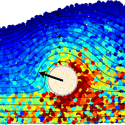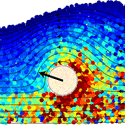Grainy picture
Lift and drag—the forces that allow an airplane to take off and land—are normally associated with an object moving in a liquid or gas. Now, a team of scientists reports in Physical Review Letters how an object’s shape affects these forces when it moves through a granular medium, like sand or beads.
Yang Ding and his colleagues at the Georgia Institute of Technology, US, designed a simple experiment to measure the upward (lift) and shear (drag) forces on differently shaped rods moving through a bed of millimeter-sized glass beads. The rods, which had either a circular, square, or half-circle cross section, were suspended from a moving platform and dragged—with their long axis perpendicular to the direction of motion—through the beads. A force sensor on the platform measured the resultant lift and drag forces on the moving rods, which Ding et al. compared with numerical simulations and a theoretical model.
The group finds that lift is downwards on the half-cylinder rod, but upwards on the square and circular rods. Variations on this type of study could help scientists understand how body shape aids a sand-burrowing animal or how to optimize the design of desert-roving robots. – Jessica Thomas





